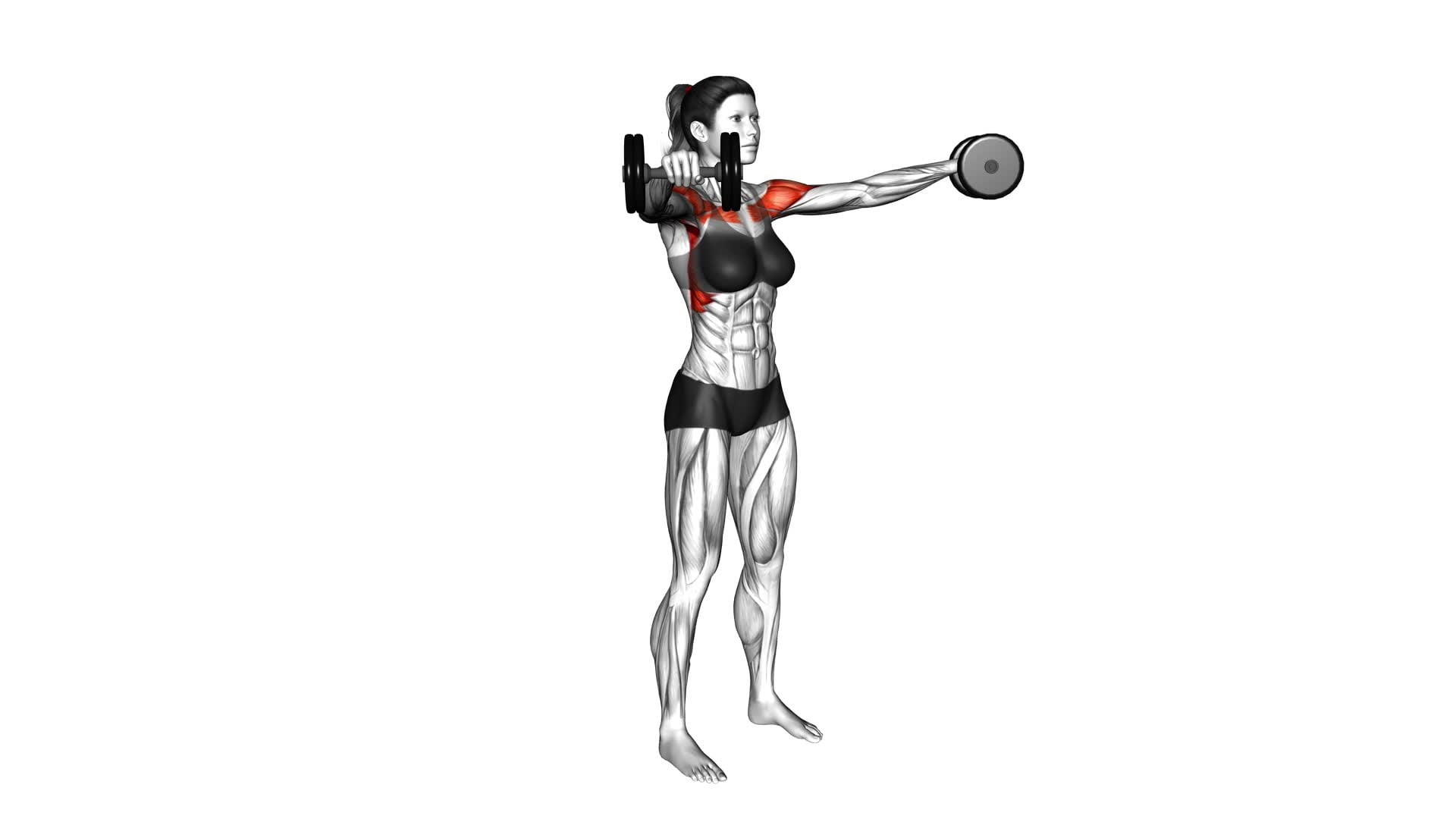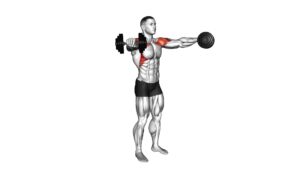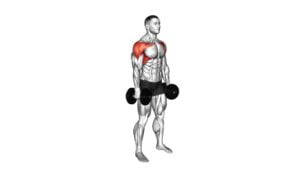Dumbbell Lateral to Front Raise (female) – Video Exercise Guide & Tips

Looking to tone your arms and shoulders? The dumbbell lateral to front raise is a great exercise for females.
Watch This Exercise Video
In this video exercise guide, you'll learn the proper form and technique, as well as variations for all fitness levels.
Avoid common mistakes and get tips for incorporating this exercise into your workout routine.
Watch the video and get ready to see results!
Key Takeaways
- The dumbbell lateral to front raise exercise targets multiple muscle groups simultaneously, including the shoulders, arms, upper back, and core.
- Proper form and technique, such as maintaining control and avoiding momentum, are crucial for maximizing the benefits of the exercise.
- Starting with lighter weights and gradually increasing resistance is recommended for females, while paying attention to muscle fatigue and seeking professional guidance if needed.
- Avoiding overexertion injuries can be achieved by using appropriate weights, warming up properly, and preventing overuse injuries and muscle strains.
Benefits of the Dumbbell Lateral to Front Raise
One benefit of the Dumbbell Lateral to Front Raise is that it helps you strengthen multiple muscle groups simultaneously. This exercise primarily targets the shoulders, but it also engages the muscles in your arms, upper back, and core. By performing the Dumbbell Lateral to Front Raise, you can effectively develop strength and stability in these areas.
The Dumbbell Lateral Raise is a shoulder exercise that specifically targets the lateral deltoid, which is the muscle responsible for raising your arms out to the sides. This exercise helps to strengthen and tone this muscle, resulting in improved shoulder definition and stability.
Additionally, by transitioning into the Front Raise part of the exercise, you engage the anterior deltoid, which is the muscle responsible for raising your arms to the front. This dual movement helps to develop well-rounded shoulder strength and balance.
Proper Form and Technique for the Exercise
To execute the Dumbbell Lateral to Front Raise exercise correctly, maintain a strong and stable posture throughout the movement. Here are some tips for incorporating proper form and technique:
- Stand tall with your feet shoulder-width apart and a slight bend in your knees. Keep your core engaged and your chest lifted throughout the exercise.
- Hold a dumbbell in each hand with an overhand grip, palms facing your body. Keep your arms straight and relaxed by your sides.
- Begin the movement by raising your arms out to the sides, keeping them parallel to the floor. Avoid any swinging or jerking motions.
- Once your arms are parallel to the floor, smoothly transition into a front raise by bringing your arms forward, keeping them at shoulder height. Maintain control and avoid using momentum.
Common mistakes to watch out for include using too much weight, which can compromise form, and lifting the dumbbells too high, which can strain the shoulder joints. Remember to start with lighter weights and gradually increase as you build strength and confidence.
Focus on controlled movements and maintaining proper posture throughout the exercise.
Recommended Dumbbell Weights for Females
When choosing dumbbell weights for your workout, it's important to consider a few key factors.
It's recommended to start with lighter weights and gradually increase the resistance as you become stronger and more comfortable with the exercise.
This will help you avoid overexertion injuries and allow you to maintain proper form and technique throughout your workout.
Weight Selection Tips
Choose dumbbell weights that are appropriate for your strength and fitness level. Here are some weight selection tips to help you avoid overexertion injuries:
- Start with lighter weights: If you're new to strength training or have limited upper body strength, begin with lighter dumbbells. This will allow your muscles to adapt and prevent strain or injury.
- Gradually increase the weight: As you get stronger, gradually increase the weight of the dumbbells. Aim for a weight that challenges you but still allows you to maintain proper form throughout the exercise.
- Listen to your body: Pay attention to how your muscles feel during and after the exercise. If you experience excessive fatigue, pain, or discomfort, it may be a sign that the weight is too heavy for you. Don't push yourself beyond your limits.
- Seek professional guidance: If you're unsure about the appropriate dumbbell weight for you, consider consulting a fitness professional. They can assess your strength and provide personalized recommendations.
Avoiding Overexertion Injuries
Select dumbbell weights that are suitable for your strength and fitness level to prevent overexertion injuries. It's important to choose weights that challenge you without putting too much strain on your muscles. Using weights that are too heavy can lead to overuse injuries, such as muscle strains or joint pain.
On the other hand, using weights that are too light may not provide enough resistance to effectively strengthen your muscles. Before starting your dumbbell lateral to front raise exercise, it's crucial to warm up properly. This can be done by performing dynamic stretches and light cardio exercises to increase blood flow to your muscles and loosen up your joints.
Variations and Modifications for All Fitness Levels
To modify the dumbbell lateral to front raise exercise for different fitness levels, adjust the weight and range of motion. Here are four variations and modifications that you can incorporate into your workout routine:
- Lighter weights: If you're a beginner or have limited upper body strength, start with lighter dumbbells. This will allow you to focus on maintaining proper form and avoid straining your muscles.
- Increased range of motion: As you become more comfortable with the exercise, you can gradually increase the range of motion by lifting the dumbbells higher during the lateral and front raises. This will engage your shoulder muscles more effectively and provide a greater challenge.
- One arm at a time: Another option is to perform the exercise one arm at a time. This can help improve balance and stability while allowing you to focus on each shoulder individually.
- Resistance bands: If you don't have access to dumbbells, you can use resistance bands instead. They provide a similar level of resistance and allow for a wide range of motion.
Remember to listen to your body and adjust the exercise according to your fitness level. By incorporating these variations and modifications, you can continue to challenge yourself and make progress towards your fitness goals.
Common Mistakes to Avoid During the Exercise
One common mistake to avoid during the dumbbell lateral to front raise exercise is lifting the weights too high, which can strain your shoulder muscles. When performing this exercise, it's important to remember that the goal is to engage the lateral deltoids and the front deltoids, not to lift the weights as high as possible. Lifting the weights too high can lead to overextension of the shoulder joint, putting unnecessary stress on the muscles and increasing the risk of injury.
Another common error to avoid is using momentum to lift the weights instead of relying on your muscles. It's important to maintain control throughout the entire range of motion and avoid swinging the weights up with your body. This not only reduces the effectiveness of the exercise but also increases the risk of straining your muscles or losing balance.
Additionally, it's crucial to avoid using weights that are too heavy for your current strength level. Using weights that are too heavy can compromise your form and increase the risk of injury. Start with lighter weights and gradually increase the resistance as you become stronger and more comfortable with the exercise.
Tips for Incorporating the Dumbbell Lateral to Front Raise Into Your Workout Routine
To incorporate the dumbbell lateral to front raise into your workout routine, try adding it as a shoulder exercise on your upper body training days. This exercise targets the deltoids and can help improve shoulder strength and stability.
Here are some tips to help you incorporate this exercise effectively:
- Start with light weights: Since this exercise involves lifting the arms in two different directions, it can be challenging. Begin with light dumbbells to ensure proper form and avoid straining your muscles.
- Focus on proper technique: Keep your core engaged and maintain a slight bend in your elbows throughout the movement. Lift the dumbbells out to the sides with a slight bend in your elbows, then rotate them forward until they're in front of your body.
- Control the movement: Avoid using momentum to lift the weights. Instead, focus on controlled movements and feel the muscles working throughout the exercise.
- Include variations: Once you have mastered the basic dumbbell lateral to front raise, you can incorporate variations such as performing the exercise while standing on one leg or adding a pause at the top of the movement.
Incorporating dumbbell exercises like the lateral to front raise into your upper body workout routine can help you achieve a well-rounded and effective workout. Experiment with different variations and challenge yourself as you progress.
Frequently Asked Questions
Can Men Also Perform the Dumbbell Lateral to Front Raise Exercise?
Yes, men can definitely perform the dumbbell lateral to front raise exercise. This exercise isn't gender-specific and can benefit anyone looking to strengthen their shoulder muscles.
The dumbbell lateral to front raise targets the deltoids, helping to improve overall shoulder strength and stability. By incorporating this exercise into your workout routine, you can enhance your upper body strength and promote better posture.
How Many Sets and Reps Should I Do for This Exercise?
For the dumbbell lateral to front raise exercise, it's important to focus on sets and reps to get the most out of your workout.
To determine the number of sets and reps, consider your fitness level and goals. Typically, starting with 2-3 sets of 10-12 reps is a good place to begin.
Remember to maintain proper form throughout the exercise, keeping your core engaged and avoiding any swinging or jerking motions.
Is It Necessary to Warm up Before Performing the Dumbbell Lateral to Front Raise?
Yes, it's necessary to warm up before performing the dumbbell lateral to front raise. Warming up helps to increase blood flow to your muscles, making them more pliable and less prone to injury. It also prepares your body for the exercise by activating the muscles you'll be working.
Incorporating the dumbbell lateral to front raise into your workout routine has many benefits, including targeting your shoulder muscles and improving upper body strength.
To perform it correctly, stand with your feet shoulder-width apart, hold the dumbbells at your sides, and raise them out to the sides and then in front of you while maintaining a slight bend in your elbows.
Can I Use Resistance Bands Instead of Dumbbells for This Exercise?
Yes, you can definitely use resistance bands instead of dumbbells for the lateral to front raise exercise. Resistance bands provide a different type of resistance compared to dumbbells, which can help improve your strength and stability.
They also offer the advantage of being portable and versatile, allowing you to easily adjust the resistance level. Incorporating resistance bands in your strength training routine can provide a variety of benefits, such as increased muscle activation and improved joint stability.
Should I Perform This Exercise on an Empty Stomach or After Eating?
When deciding whether to perform the dumbbell lateral to front raise on an empty stomach or after eating, consider your personal preferences and comfort levels. Some people find it easier to exercise on an empty stomach to avoid discomfort or digestive issues. However, others may prefer to have a light snack before the workout for extra energy.
It's important to listen to your body and do what feels best for you. As for women, the dumbbell lateral to front raise can help strengthen and tone the shoulders, giving a more defined and sculpted appearance.
Conclusion
Incorporating the dumbbell lateral to front raise into your workout routine can provide numerous benefits for females.
With proper form and technique, this exercise can help strengthen the shoulder muscles and improve overall upper body strength.
It's important to choose the appropriate dumbbell weights for your fitness level and avoid common mistakes to maximize the effectiveness of this exercise.
By following these tips and modifications, you can effectively incorporate the dumbbell lateral to front raise into your fitness routine.

Author
Years ago, the spark of my life’s passion ignited in my mind the moment I stepped into the local gym for the first time. The inaugural bead of perspiration, the initial endeavor, the very first surge of endorphins, and a sense of pride that washed over me post-workout marked the beginning of my deep-seated interest in strength sports, fitness, and sports nutrition. This very curiosity blossomed rapidly into a profound fascination, propelling me to earn a Master’s degree in Physical Education from the Academy of Physical Education in Krakow, followed by a Sports Manager diploma from the Jagiellonian University. My journey of growth led me to gain more specialized qualifications, such as being a certified personal trainer with a focus on sports dietetics, a lifeguard, and an instructor for wellness and corrective gymnastics. Theoretical knowledge paired seamlessly with practical experience, reinforcing my belief that the transformation of individuals under my guidance was also a reflection of my personal growth. This belief holds true even today. Each day, I strive to push the boundaries and explore new realms. These realms gently elevate me to greater heights. The unique combination of passion for my field and the continuous quest for growth fuels my drive to break new ground.







